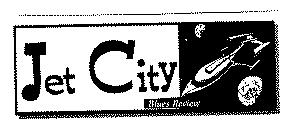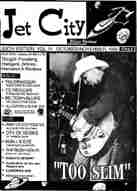

 |
|
|
|
|
| Jet City Blues Stories | |
| TAILDRAGGER |
The Story of a Western "Blues" ManBy Shannon D. LoveWritten and interview conducted in 1995
Tim was fast becoming a music admirer and
connoisseur -- well before he ever took up any musical instrument. Tim
recalls when he was four years old he would play his parent's old
phonograph and radio all day long -- one song in particu By the time young Tim was a teenager he had picked up the drums and could bang out a tune or two, but nothing too serious. Baseball and sports would monopolize most of his time, although he had the largest record collection of all his friends and music was the coolest, it did not consume his whole existence... until his first concert, ZZ Top. It was all young Tim could do to contain himself. He loved the excitement and euphoria that came over the audience. Tim knew then that he wanted to play guitar. Young Tim borrowed a guitar from his good friend Forest Shoemaker, an old Harmony acoustic, so he could take lessons with his other friend, Tom Castor. The two started lessons together, each of their parents alternated driving the two back and forth. Tim was always jealous of Tom. Tom had his father's electric Gibson 125 guitar and all Tim had was that beat-up old Harmony. But Tim would get his revenge later on Tom. After three weeks, their teacher, Fritz Henkal said that the two of them could not continue taking lessons together, because Tim had rapidly advanced beyond Tom's scope of the instrument. Mr. Heckle thought it would be wise to schedule separate appointments for the two from now on. And, of course, this was music to Tim's ears. Music came to Tim as a song on a record, and it was the records that Tim would eventually learn from. Tim had an ability to hear a song and within moments know how to play the song effectively. In high school Tim joined the jazz band. In those two years Tim learned how to read and write music and fuse musical styles together. Up to this point Tim was listening to Jimi Hendrix, Cream, Leonard Skinnard, basically, second generation blues fans.
After high school Tim received a scholarship to Eastern Washington University as a jazz guitarist for the jazz choir. Tim pretty much thought the materiel they were doing was square and corny and felt that nobody was into the music. That resulted in Tim quitting after attending school for one year. Tim then joined the local community college and joined their jazz band, and would eventually take drum lessons to further his knowledge. Tim's real desire was to play his own music, but up until this point Tim hadn't met a lot of players that shared his zest for the music he calls the blues. None of the drummers that Tim had played with knew what a shuffle was. Every time Tim would explain a shuffle, the drummer would get this puzzled look on his face. So Tim took drum lessons so he would understand the criterion behind a shuffle, and then he could get behind the drums and say, "No man, do it like this." Tim was in his own world, the blues. When Spokane bands were playing nothing but Top 40 music Tim was learning the blues. Tim would go to the local jams, and he would get up on stage and the players would call off some of the top 40 songs. Tim had no idea what they were talking about, so Tim would get up there and play blues. The players would snicker under their breath, and soon the Top 40 guys started mocking Tim as "The Blues Guy".
Once inside, Tim found a table up front with a good view of the band and was ready for the first song of the night. Robert Cray started the set with a blistering guitar solo and Tim's jaw fell to the floor, mesmerized by what he was seeing and hearing, definitely awestruck of Cray's abilities on the guitar. At the break Tim approached Cray, but nothing but gibberish was coming out of Tim's mouth, something to the effect of, "I love your band, man. You guys are so hot!" Cray was polite and diplomatic and stepped back a step and said, "Thank you." Tim came back every night they were in town and watched every lick Cray played how he played his chords. He checked out the gear he was using, and checked out every player in the band. As Tim put it, "I tried to steal ever thing I could from him." Over the years Tim would follow the Cray band, and check them out whenever he could. He became friends with all the guys in the band, eventually helping Tom Dorm, Cray's sound guy, with the mix when he had to step away for a refreshment. This left a lasting impression on Tim for the rest of his life.
For the next two years Tim played every Friday and Saturday night at a club called the Swinging Doors. Tim was a paid musician, and doing what he loved, playing music. But Tim wanted to play something a little more up-beat. Tim still had his job at the Red Lion and the lounge was going to start a 50's night on Sunday nights. The general manager of the Red Lion knew that Tim was a musician and asked if he was interested in putting together a 50's show band. Tim thought it was a great concept and called some of his friends from college. Tim put together a trio -- bass and drums and himself on guitar and a singer as the front man. They called themselves, The Studebakers.
The Studebakers evolved as the months passed. As the style of the typical 50's doo-wop sound was slipping away, it was replaced with the thunder of rock-a-billy music. And with that change, Tim managed to slip in old blues standards to the song list, a direction Tim was thrilled about. Now, the other members in the band liked the earlier sounds of the band, more like the sounds of a band called Flash Cadillac and The Continental Kids. A few more months went by and the band members were becoming more disgruntle with the new direction. Tim was the boss, and he wasn't about to go back. Tim had some determined ideas about the direction, so he fired the whole band and started another version of the Studebakers. The band went hard core rock-a-billy and started to travel across the state and found themselves playing the Central Tavern in Pioneer Square and down in Portland. The Stray Cats were on top of the charts, and the Studebakers were in demand. Soon the band turned in to a punk-a-billy band, doing Iggy Pop and Lou Reed songs to a rock-a-billy sound. The Studebakers were being managed out of Hollywood, California, and the band found themselves playing all over the western states. On one such occasion they found themselves in a little town in Montana. Tim recalls the experience, "Yeah were playing our set of originals, having a good time and this yeah-hoo starts yelling and swearing at me to play AC DC, disrupting everyone. So I told him to shut up, and he jumped me on stage, knocked me in to the drums and started pounding on me. These geologists intervened and took the guy out back and proceeded to beat the living daylights out of him. It's not easy playing the music you believe in." Tim had picked up an old school bus to travel to Southern California. The Studebakers recorded an LP while they were there. Unfortunately it was never released and the money never came. The whole reason for being in California was becoming senseless. Feeling stranded, living in their bus for months, the boys just wanted to go back home. Playing until they could raise the cash to make that dash for home became the band's main mission. Everything was going wrong. Tim recalls some of the band's frustrations, "Things got out of control, the music went down hill, the emphasis shifted from the music, to how drunk could we get on stage. We were spraying beer all over the place. People started stage diving. I just got real tired of the whole thing. And I still wanted to play the blues."
The Taildraggers pounded hard all over the Northwest playing many of the smaller clubs and honky-tonks that featured live music. Paying their dues once again as they started anew. They all had been there before, but this time it would be different. Tim was doing the booking and the band was going to play the clubs that they wanted to play. The Taildraggers were rapidly developing a powerful regional draw across the West for their unadulterated Western Man approach to the blues. In 1988 the town of Winthrop hosted the First Annual Winthrop Rhythm & Blues Festival. Too Slim and The Taildraggers were called upon because of their strong fan base from the east side of the mountains. The people came in droves, and the show rocked. It was a smashing success, with many of the thanks going to the Taildraggers.
In 1990 the Taildraggers released their first CD, Rock 'em Dead, and then El Raunco Grunge in 1992, both recorded in San Francisco, while on a California tour. Both CD's are now available on the Burnside Record label. The group's next CD on Burnside was, Wanted...Live, recorded July 3, 1993 at the Portland Waterfront Blues Festival and December 28, 1994 at the Central in Seattle, Washington. Burnside wanted a project out that they were directly involved with. The two projects before were financed solely by the Taildraggers, with the first CD being distributed by Criminal Records. The Taildraggers met Terry Currier from Burnside, about the time they were finishing up with El Rauncho Grundge. The Boys signed with Burnside and Burnside quickly put out Wanted...Live, and were working on a new release that will hit the streets in November of 1995, called Swamp Opera, featuring Little Charlie Baty, Jimmy Pugh, and Charlie Musclewhite, all who have reached out a hand and helped the Taildraggers over the years.
By playing the honky-tonks and
festivals over the years, the Taildraggers dedication and hard work
throughout the northwest has paved the way and inspired many of our local
bands. They have convinced the public that live blues music is definitely
where it's at, and that their signature style, western blues, rocks.
|
Shannon Love Professional Auto Consultant -- Call (206) 251-6428
e-mail -- Sales@ShannonLove.com